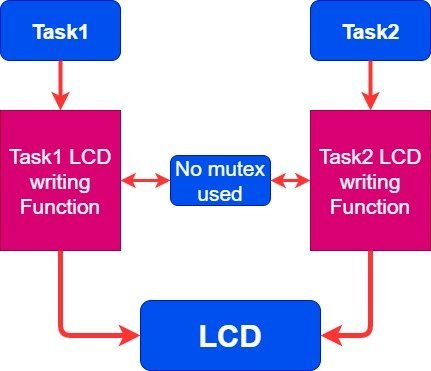On an interrupt routine I’ll have to use:I’m using Binary Semaphores for interrupt synchronization.as state on the FreeRTOS book:The syntax of the interrupt service routine declaration and the macro called to force a context switchare both specific to the Open Watcom DOS port and will be different for other ports. Please refer tothe examples that are included in the demo application for the port being used to find the actual syntaxrequired.static void __interrupt __far vExampleInterruptHandler( void ){ static portBASETYPE xHigherPriorityTaskWoken; xHigherPriorityTaskWoken = pdFALSE; /* ‘Give’ the semaphore to unblock the task. */ xSemaphoreGiveFromISR( xBinarySemaphore, &xHigherPriorityTaskWoken ); if( xHigherPriorityTaskWoken pdTRUE ) { /* Giving the semaphore unblocked a task, and the priority of the unblocked task is higher than the currently running task – force a context switch to ensure that the interrupt returns directly to the unblocked (higher priority) task. NOTE: The actual macro to use to force ISR is dependent on the port. This is Open Watcom DOS port. Other ports may Refer to the examples provided for the the syntax required. */ portSWITCHCONTEXT(); a context switch from an the correct macro for the require different syntax. port being used to determine }}As such portSWITCH_CONTEXT is port dependent. I cannot find this function in the port of pic24F and interrupt handler function static void __interrupt __far vExampleInterruptHandler( void ), __asm{ int 0x82 } this line generates the interrupt. /* Install the interrupt handler. */ _dos_setvect( 0x82, vExampleInterruptHandler );Could you please explain this in detail to me.
Quote: ” When you post a simulated interrupt is sets a bit in a control variable to tell the port which ISR it should execute, then invokes the port layer code which does the necessary.”Yes, that’s corresponding to the (working) example code, I see that concept.But in my oppinion it would be good to have another use case for simulating interrupts on Windows. I think it would be more comparable to a “real” uC if the ISR can directly be called by the user (see my example in https://sourceforge.net/p/freertos/discussion/382005/thread/a7385a2d/)So instead of setting a flag with the “vPortGenerateSimulatedInterrupt” function just call the ISR directly (e.g. in a high priority WINDOWS thread). I am aware that this solution would be more error prone but it would give more flexibility (and better interrupt timing accuracy) for certain use cases.But I am not (yet) fully aware of the FreeRTOS internas to see how this could be enabled in the FreeRTOS windows port. But this use case is quite comparable to a “real” hardware, I guess it should be possible with some (hopefully) simple modification in the windows port. I will also try to work on that feature if necessary but first I am interesed in the oppinion of the FreeRTOS experts.
Freertos Interrupt Handler Example
Loss of InterruptsPosted by dave—w on July 24, 2017Hi, I’m stuck trying to figure out why I’m losing bytes with a UART ISR. I send and receive packets of data and rarely I’m missing a byte on the receive side. (CRC causes the message to fail.) This happens on 2 different Microchip PICs, PIC32MX460F512L. A complete list of FreeRTOS tutorials with Arduino. It consists of these topics: 1. Task Management 2. Queue Management 3. FreeRTOS Software Timers 4. Interrupt Management 5. Binary Semaphore 6. Counting Semaphore 7. Mutex (Mutal exclusion) 8. Gatekeeper Tasks 9. Event Groups 10. Task Notifications.

